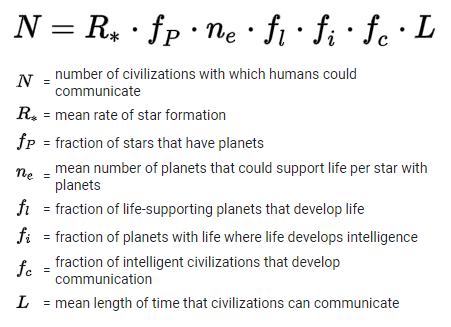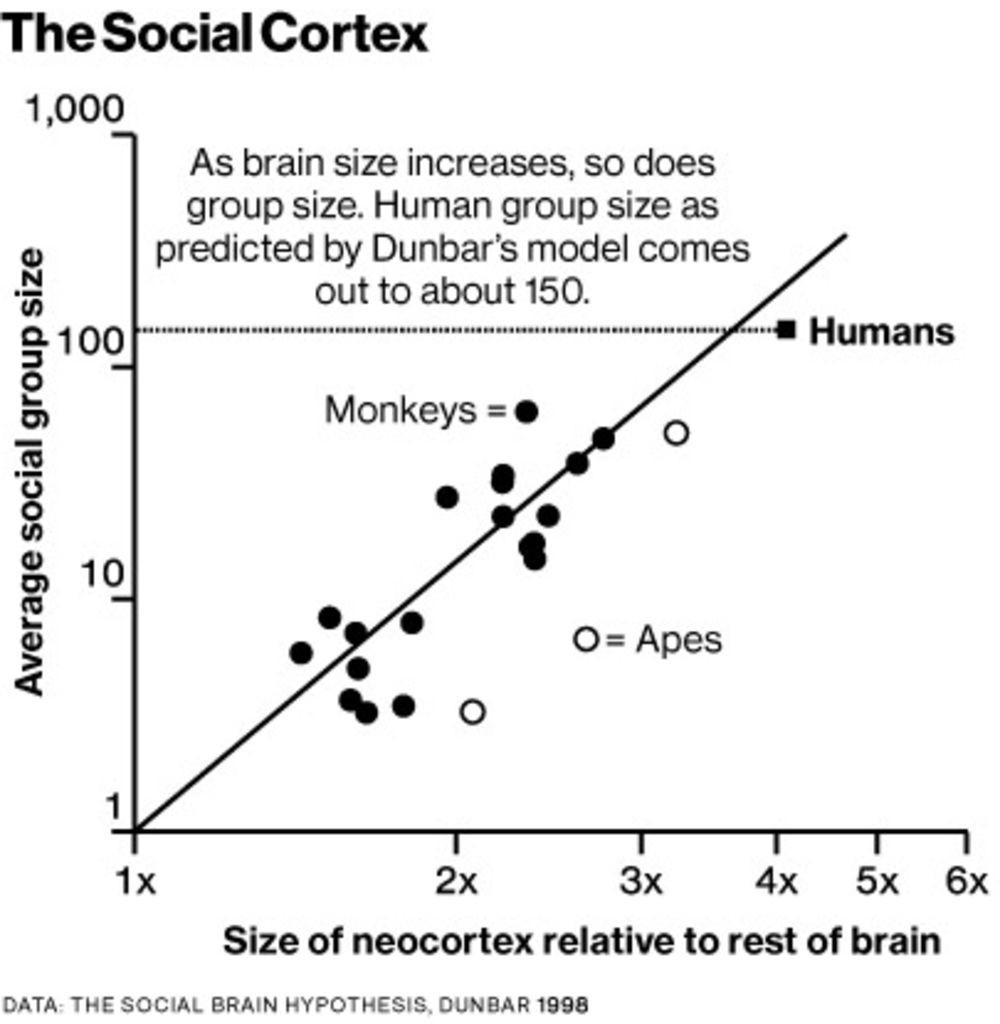Welcome back to our discussion on the Drake Equation and the Fermi Paradox! If you haven’t read parts 1 and 2 already, it goes without saying that you should start there! This time we’ll be discussing what we know about the evolution of intelligence and communication… or at least what we think we know. This part is going to be more philosophical and speculative than the last two, but unlike a certain notorious tv show, our aim will be informed speculation.
 The poster child for uninformed speculation
The poster child for uninformed speculation
Before we dive into our discussion, we first need to clear up a common misunderstanding surrounding the evolution of intelligent life: the notion that intelligence is ‘more evolved’ and thus evolution has been “building up” to it all along. Evolution by natural selection is a process by which a species’ genetics change over successive generations to better fit their environment. It is not a guided process with an end goal, nor does it converge to a single result in a given environment. If it did, the word ‘biodiversity’ wouldn’t be part of our lexicon. Intelligence is an example of complexity, but complexity is not synonymous with ‘most evolved’. In fact, the most evolved species are generally those which are the least complex because they reproduce the fastest and have been around the longest. These two factors allow for the greatest number of environmental adaptations to take place in a species. For example, the bacteria in your digestive system are several million times ‘more evolved’ than either you or I are. While it’s certainly true that intelligence provides a substantial survival advantage, this is not unique. By definition all adaptations provide survival advantages, and those that help to survive the threat of mass extinction events should also be considered. In that light, the organisms living around geothermal vents on the ocean floor take first prize. Genetic and molecular clock modelling suggests that the last universal common ancestor (LUCA), to which all extant life originated from, was just such an organism. To put it simply, LUCA was most likely an organism that survived a massive planetary extinction event which wiped out all other genetic lineages around 4 billion years ago. This makes it and life like it not only the ‘most evolved’, but arguably the most capable survivors.
With that out of the way, let’s examine some more factors!
Fraction of Inhabited Planets that Develop Intelligent Life, Fi
The first thing to note is that this factor is heavily debated, with estimates more or less divided into two camps: those who argue this number is very small, and those who argue it’s close to 1. For simplicity, we’ll refer to these as “Rare Intelligence” and “Inevitable Intelligence”, respectively.
Rare Intelligence
Anatomically modern humans arose only very recently, around 200,000 years ago, civilization a mere 12,000 years ago, and recorded history began a paltry 5,000 years ago. As a percentage of the total time life has existed on Earth, these account for 0.005%, 0.0003%, and 0.0001%, respectively. The precursor hominids (i.e. not Neanderthals or Denisovans) to our own species did not have the intellectual capacity to become broadcasting civilizations. They never even developed agriculture, which enabled specialization. This was a critical step in making the switch from isolated, nomadic tribes to densely populated cities. Even if high intelligence is a generic product of the evolutionary process, the enormous amount of time it may take to evolve places constraints on our estimates given the current age of the universe. If the development of intelligence is limited to planets around stars of similar mass to our own, then the window for it to develop is limited to around 5 billion years. In around 1 billion years the sun’s brightness will have increased, significantly raising our planet’s temperature to the point that (unless we do something about it) the Earth will be completely uninhabitable. Thus if intelligence takes on average a few billion years to develop, when a planet only has a few billion years of habitability to begin with, we would expect relatively few organisms to ever develop intelligence.
David Kipping, from Columbia University’s department of astronomy, recently performed an objective Bayesian analysis on this topic in an attempt to determine just how likely intelligent life is to evolve on other planets given what we know about Earth. Unlike other methodologies, Bayesian analysis seeks to directly compare two or more competing hypotheses in order to determine which explanation is most probable. Using this methodology, he determined that the odds of life arising very soon after a planet becomes habitable may be as high as 9:1. However the evolution of intelligence is far less constrained, with 3:2 odds of intelligence being rare. As we learn more about our own planet’s history and perhaps finally detect life on another planet, these odds will shift quite a bit. The key to this sort of analysis is that the odds can be refined as more information is gained. While the odds of intelligence being common don’t look good at the moment, they have plenty of room to improve.
For simplicity, we will set the fraction of planets that develop intelligent life under the assumption of rare intelligence at roughly 9:1 odds: Fi,Rare = 0.1.
Inevitable Intelligence
Though it took billions of years for intelligence to evolve, we don’t actually know for certain just how long it will survive. Drawing conclusions about the frequency with which intelligent life develops based on Earth’s history thus far is fundamentally flawed. If, for example, intelligent Earth life were to continue on for another trillion years, long after the Sun and Earth are gone, then intelligent Earth life would have been around for 99.6% of the total time Earth life existed. If Earthly intelligence survives until the end of the Stelliferous Era, that percentage increases to 99.996%. Even if Earth life never becomes interplanetary, then our time here is hard-capped at around 7.5 billion years and intelligent life will have accounted for 65% of life’s existence on the planet. Unless we wipe ourselves out tomorrow (a topic we will revisit in Part 4 of this series), the previous analyses of our existence as a fraction of the time life has currently existed on Earth is irrelevant. If we allow for the possibility that life can develop on worlds orbiting red dwarf stars, then the window of habitability could be trillions of years rather than a mere 5 billion.
Lesser extinction events don’t prohibit evolution to intelligence unless they happen frequently enough that multicellular life can’t gain a long-lasting foothold on the planet before the host star burns out. Given the fast pace at which even the slowest-reproducing life evolves compared to how long typical life-supporting stars live, extinction events would need to be so frequent that such a planet arguably wouldn’t be considered habitable in the first place. It’s only been around 66 million years since the last ‘big one’ hit, a length of time representing less than 2% of the total time that life has existed on the planet, and less than 1% of the sun’s total lifetime. During that short span, mammals progressed from near the bottom of the food chain to dominating the entire planet. Geographically speaking, humans are the most widely distributed single species on land*. In the ocean, that award goes to the killer whale. Both of these species are mammals and both are at the top of their respective food chains. Life has recovered similarly quickly after other mass extinctions events, so we should only expect frequent, near-total extinction of life on a planet to prohibit the development of intelligence. If intelligence ever does arise, then if/when it later goes extinct will be accounted for with the final value in the equation, L.
 The Land Before Time CLXVII: The Great Space Rock Adventure
The Land Before Time CLXVII: The Great Space Rock Adventure
Again, for simplicity, we will set the fraction of planets that develop intelligent life under the assumption of inevitable intelligence Fi,Inev = 1.
Fraction of Intelligent Civilizations that Develop Detectable Communication, FC
In our discussion of the Drake Equation thus far, we’ve swept an important detail under the rug: how exactly would we detect intelligent extraterrestrial life? The prevailing presumption in all analyses of the Drake Equation has, until very recently, been that we would detect signs of intelligent life via their radio broadcasts. At the time the equation was penned, that was the only pragmatically conceivable means for detecting alien intelligence beyond our solar system. This factor is also disputed, but less so than the previous one. In most conceivable scenarios, it’s likely that intelligent life will eventually develop electromagnetic communication techniques if left to its own devices, as intelligence does provide a great survival advantage once it has developed. Even though complex brains are an enormous energy investment, one of the primary advantages they ultimately provide, through the development of agriculture, is complex societies that enable individuals within a species to become highly specialized and efficient in various tasks. Using the Pareto Principle, a general mathematical principle which states that a majority of the results come from a minority of the causes, we can surmise that an 80% efficiency level in most skills can be attained with around 20% of the effort. Beyond this, the effort required for incremental efficiency attainment increases exponentially. You’re likely familiar with this concept, even if you don’t recognize the name. Anyone who has learned to play an instrument knows that learning how to play all the notes takes only a few months, but true mastery of more advanced techniques like circular breathing can take a lifetime of daily practice. Our nomadic ancestors couldn’t afford to invest limited resources on specializing in a single skill because the marginal returns were low. In contrast, a society with a food surplus (that is, an energy surplus) can afford to make that investment and quite literally ‘reap’ the benefits they ‘sowed’. That’s not to say we don’t see socialization or specialization elsewhere in nature, but never to the same extent as in human societies.
The sheer degree to which we socialize and specialize in and of itself necessitates an advanced capability like communication through language. The further advancement of this capability into the Information Age has provided us with survival benefits the likes of which our ancestors would never have dreamed of. It’s possible that intelligence, sociality, and advanced communication capabilities are paired at a deep level. Using our own brains as a model, we might reasonably expect that natural selection will disfavor intelligence that does not possess a comprehensive capability to communicate. Similarly we can expect such capabilities to generally trend towards the use of electromagnetic technologies since the speed of light is the fastest possible way to transmit information. While it’s certainly plausible that there may be a species of strong, independent geniuses out there in the cosmos who can comprehend General Relativity by the age of 10, their time spent not doing the basic things required to survive is just as limited as yours or mine. Such capabilities, impressive as they would be, don’t automatically outweigh the benefits of being a social animal. After all, you can’t exactly eat the Einstein Field Equations.
We generally measure intelligence in humans with the intelligence quotient, but IQ tests are designed for humans and can’t be generalized to other species. In theory, we could instead estimate a species’s intelligence by measuring their degree of sociality, but how exactly would one do that? Dunbar’s Number aims to measure the maximum number of other members of a species with whom its members can maintain meaningful relationships. In his original work, Robin Dunbar compared the relative neocortex sizes of different primates to the average sizes of the social groups they formed and found that the average human social group size is approximately 150. Some real-world examples of Dunbar’s Number include the average size of Hunter-Gatherer societies, average size of Christmas card networks, average number of wedding guests, size of the Roman Maniple, average size of an English Village in the 11th century, and even the number of Super Bowl rings the NFL gives to the winning team each year.
The link between neocortex complexity, intelligence, and social behaviors means that a species with a larger Dunbar’s Number would generally have higher intelligence, more cooperation, and a higher degree of specialization. These, in turn, contribute to a more rapid pace of technological development. In contrast, a species with an extremely low Dunbar’s Number will have lower intelligence, difficulty cooperating, less specialization, and slower development of technology. As we consider species with lower and lower values, eventually one will be less likely than not to develop electronic communication. Since the values for other primates aren’t all that far behind ours, this lets us set a measurable baseline for what we mean by ‘intelligence’ insofar as the Drake Equation is concerned.
Of course there are a plethora of conceivable exceptions to this rule, but most fall apart under closer scrutiny. Some insect species live in colonies of more than 100,000, so what about a species of hyper-intelligent alien insectoids like the Formics in Ender’s Game? What about a species of ocean-dwellers with human level intelligence that nonetheless never develops electronic communication due to their aquatic environment? As intriguing as these and other Sci-Fi aliens may be, insects don’t have a neocortex and even the most intelligent sea creatures lag far behind humans. If we wish to extrapolate characteristics of Earth creatures, we should aim to be consistent rather than picking and choosing which features we want them to have.
 On a planet somewhere in the infinite universe… probably…
On a planet somewhere in the infinite universe… probably…
Since we expect what we generally define as intelligence to go hand-in-hand with the development of electronic communication, we will set FC ≈ 1.
As a final note, the Drake Equation was formulated under the assumption that alien intelligence could only be detected via radio signals. With the launch of the James Webb Space Telescope fast approaching, the landscape of possible methods for detecting an extrasolar intelligent civilization are about to shift dramatically. The ability to detect the atmospheric compositions of extrasolar worlds will give us our first chance at detecting alien life forms through the spectroscopic signatures of volatile chemicals they leave in their atmosphere.
Next time, we’ll be discussing the final factor in the Drake Equation as well as what it and equations like it actually are.




